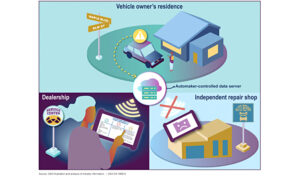Despite predicted EV model introductions in the next 5 years, ICE vehicles will generate aftermarket product growth to 2030 and beyond
Fort Wayne, Ind.—Electric Vehicles (EVs) currently comprise just over 1 percent of light vehicles in operation (VIO). And although carmakers will flood dealership showrooms with new and improved EV models over the next 5 years, EVs face a long sales road before they represent a large portion of the country’s VIO, according to a new study.
Based on the relatively small EV population and its low average age through the balance of the decade, Lang Marketing predicts that internal combustion engine (ICE) vehicles will generate aftermarket product growth to 2030, and beyond.
Lang Marketing also reports the following.
EV Sales Have Not Reached Main Street U.S.
• EV sales in the U.S. have lagged the EV adoption rate of many major countries. In the 5 years prior to the onset of COVID-19, EVs in the U.S. averaged less than 2 percent of car and light truck sales.
• Plug-in Hybrid Electric Vehicles (PHEV) and Battery Electric Vehicles (BEV) have yet to enter the mainstream of the U.S. light vehicle market.
EV Sales: 2020 and 2021
• EV sales fell in 2020, along with total car and light truck volume. However, the impact of COVID-19 on EV volume was less severe than on ICE Vehicles, and EVs increased their 2020 sales share to 1.5 percent.
• EVs (PHEVs and BEVs) will account for approximately 2.5 percent of 2021 light vehicle sales.
EV Future sales
EV popularity will increase, bolstered in large part by the flood of new EV models reaching dealership showrooms. This increase of new EV models is due largely to the carmakers’ expectations that consumers will rapidly shift to EVs, rather than stemming from a groundswell of consumer demand for EVs. This could cloud EV sales in the coming years.
EV Future VIO
While EVs will steadily increase their share of new car and light truck sales in the U.S. during the 2020s, their share of VIO will climb at a much slower pace. Even with aggressive sales growth, EVs will account for only approximately 7 percent of cars and light trucks on U.S. roads by 2030.
EV Aftermarket Impact Delayed
Aside from tires and certain accessories, cars and light trucks do not make substantial contributions to aftermarket product volume until they are at least five years old.
The repair-age sweet-spot (vehicle age categories with above average rates of aftermarket product volume) for most products ranges between six and 10 years and for many products, it extends from eight to 12 years of vehicle age.
Even with rising EV sales, it will take some years before EVs will have a meaningful impact on the aftermarket.
2030 Aftermarket: EV Elimination of ICE Volume
Three major factors will limit the aftermarket impact of Electric Vehicles to 2030 and beyond.
• A significant portion of EVs on the road in 2030 will be PHEVs, which have an internal combustion engine and an electric motor. PHEVs use a wide array of conventional aftermarket parts.
• Even with strong annual sales growth, EVs will account for only approximately 7 percent of the total VIO by 2030. BEVs will represent a smaller share.
• The average age of EVs on U.S. roads during 2030 will be very low, less than 3 years. The average age of BEVs will be lower.
ICE Vehicle Aftermarket Growth to 2030 And Beyond
With their relatively small VIO and low average age, EVs will eliminate only a limited portion of 2030 ICE aftermarket volume (aside from tires and certain accessories).
Lang Marketing projects that EVs (PHEV and BEV models) will eliminate less than 2 percent of ICE aftermarket product sales in 2030. BEVs will eliminate a smaller portion. The result is that ICE cars and light trucks will continue to increase their aftermarket product volume to 2030 and beyond.




Comments are closed.